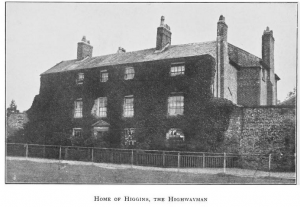Edward ‘Squire’ Higgins, Knutsford’s Gentleman Highwayman
 When Edward Higgins arrived in Knutsford in 1756 he took possession of a large house known as the Cann Office. To the local populace he appeared to be a man of high standing. He took to renovating the house and stables and bringing several fine horses, taking on two local youths as apprentices to his groom.
When Edward Higgins arrived in Knutsford in 1756 he took possession of a large house known as the Cann Office. To the local populace he appeared to be a man of high standing. He took to renovating the house and stables and bringing several fine horses, taking on two local youths as apprentices to his groom.
Attending the local hunts, with his skill on horseback and affable manner he was soon welcomed by the local gentry as one of their own. His regular excursions outside the area were assumed to be the actions of a conscientious land owner collecting the rents which funded his extravagant lifestyle.
The following year he married Katherine Birtles, a spinster from a respectable local family and they became closely entwined within local society often dining at their neighbour’s houses and hosting lavish events themselves.
